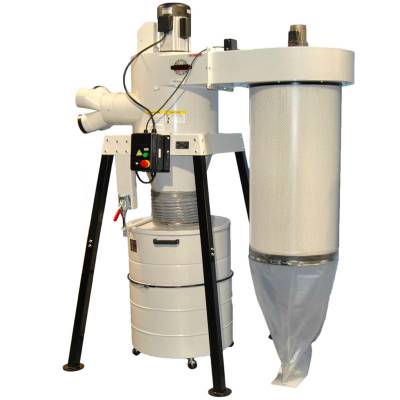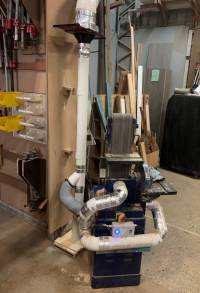Centralised Dust Extraction
Introduction

Dust extraction is a work-in-progress. At the moment we have a portable unit and the main dust collection system. The main dust collector comprises a fixed 150mm ducting around the shop, different set of blast gates and an Arduino controlled dust collector. The main controller for the system can be found in the middle of the shop.
Further reading: http://billpentz.com/woodworking/cyclone/index.php#index.php
Status of the project
what we have done
2/08/2020:
- The main 150mm ducting is done
- Most of the blast gates have been assembled and glued (first stage).
- The dust collector has been connected to the main power and the controller has been installed in the middle of the shop. This allows members to use the dust collector.
- The CAT cabling is all done.
- The Belt/disc sander has been properly plumbed and connected to the dust collection system.
What we need to do
02/08/2020
- build last-miles and connect the machines to the system.
- Finish assembling the blast gates.
- Move forward with the development of the blast gates.
Last-mile
Last-mile is the last bit of plumbing that's needed to connect a machine to the main system. Commonly you will have a blast-gate that will reduce the 150mm pipe to a 120/100/60(mm) pipe. From there you will have to go creative mode-on to figure out how to connect the machine.
Guidelines
Here's a couple of guidelines on how to do this properly:
- Try to use rigid pipe in order to improve airflow
- Don't modify the machine on a destructive way (eg. make holes on the machine, remove/cut parts of the machine, etc). If you feel that there's no other way “because life”, you can always bring the subject to discord or wednesday's woodshop meetings. You will see that two brains think better that one, and you might find out that there's a better, more efficient way to do so.
- In order to not modify machinery, you can always use different methods to hold stuff, like using VHB TAPE (Very High Bond double side tape) and zip ties.
Tips and tricks
In general terms, the piping on a central dust collection system will be made up of a main duct (bigger diameter, I our case is 150mm) and then you will have drops for the machines that are going to be smaller in diameter. The cheapest pipe you can buy to do the plumbing will be 90mm stormwater pipe. This brings a challenge with it because most machinery will be fitted with 4“ or 2-1/2” ports, so we need to accommodate for this. You can find readily available 100mm PVC pipe, but this will be DMW pipe (Drain-waste-vent) wich is a little bit thicker and “higher quality”, hence more expensive. Summarizing is better to stick to the 90mm stormwater pipe and use 100mm when you only have no other options (adaptors from 90mm to 100 are quite cheap, so the best practice is to use 100mm just to adapt the system to 90mm).
Blast gates
The blast gates are a project in itself. At this stage they are being installed to be used manually, and in the future they will be automatically controlled.
Known Problems
| Date | Description | Workaround | Proposed Remediation |
|---|---|---|---|
| 02/08/2020 | The system could turn unresponsive after it has been idle for a certain time. | Turn it off and on again using the switch beside the plug. | Fix the Arduino code. |
